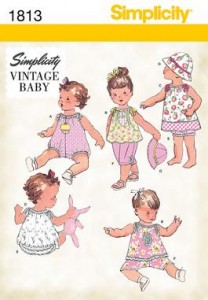 Now, when you have major ‘fabric and craft’ retailers literally offering, brand by brand, patterns at 5 for $5.00 on a monthly basis, it might seem a bit of a formal exercise to talk about all the different styles that you can get out of one pattern in order to limit the number of patterns you need to have in the stash, but bear with me here. Once you get the feel for doing this, not only do you start to recognize the ‘bones’ in the patterns (and the fact that there really are not that many different styles out there), but also realize what you can do with the patterns you’ve already made (and worked out all the fitting issues with). This is a big time-saver versus buying a new pattern, making and tweaking a muslin and so on.
Now, when you have major ‘fabric and craft’ retailers literally offering, brand by brand, patterns at 5 for $5.00 on a monthly basis, it might seem a bit of a formal exercise to talk about all the different styles that you can get out of one pattern in order to limit the number of patterns you need to have in the stash, but bear with me here. Once you get the feel for doing this, not only do you start to recognize the ‘bones’ in the patterns (and the fact that there really are not that many different styles out there), but also realize what you can do with the patterns you’ve already made (and worked out all the fitting issues with). This is a big time-saver versus buying a new pattern, making and tweaking a muslin and so on.
Now, my inspiration for doing this came years ago when I got this book by Ronda Chaney, called “Make It Your Own.” This book literally, in diagrammatic form, shows you what you do with basic patterns to change up collars, sleeves, hems, the shapes of skirts, putting panels in pants and so on. Now, the illustrations are very late 80s/early 90s, but the ideas are amazing and inspirational. You’ll never be afraid to trace your pattern and slash it ever again. And one of the reasons to sew your own things is that you can make them just…the…way…you…want..them. And this book has great lessons in how to achieve just that because it’s all based on, “If you want your sleeve to look like xxxxx, then here is what you do with your pattern to achieve just that.”
This book literally, in diagrammatic form, shows you what you do with basic patterns to change up collars, sleeves, hems, the shapes of skirts, putting panels in pants and so on. Now, the illustrations are very late 80s/early 90s, but the ideas are amazing and inspirational. You’ll never be afraid to trace your pattern and slash it ever again. And one of the reasons to sew your own things is that you can make them just…the…way…you…want..them. And this book has great lessons in how to achieve just that because it’s all based on, “If you want your sleeve to look like xxxxx, then here is what you do with your pattern to achieve just that.”
In this case, as an illustration, I used the pattern at the top, Simplicity 1813, which is an infant/toddler dress/top/bloomers and capri pants pattern. Now, once I’d made it up the first time, I realized that the whole basis of the pattern was a very loose A-line with an arm=hole, where there was a casing around the neck edge filled with some sort of tape or string that is tied at the shoulders. Very loose, very casual, very cute. But the way this works is that the neck is small enough that when you tie the strings at the shoulders, it won’t fall down over the shoulders. Important detail to remember.
Now, there are all sorts of ways to ‘ring the changes’ (as my dear old Mum used to say) on a top like this – different types of fabric, splitting up the pattern and color blocking, various trims and so on. That’s fine but it still leaves you with a top that is held together by a string going through a casing at the neck and being tied around the shoulders. What else can we do to change this into a dress or top that looks more different?
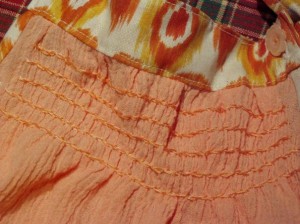 Idea number one: Smocking the top of the front and putting on shoulder straps. Now, realizing that there is a whole lot of fabric across the chest and the upper back of this top, and that the drawstring-through-the-casing at the neck is pulling it all together, this is prime territory for anything that will make this area smaller.
Idea number one: Smocking the top of the front and putting on shoulder straps. Now, realizing that there is a whole lot of fabric across the chest and the upper back of this top, and that the drawstring-through-the-casing at the neck is pulling it all together, this is prime territory for anything that will make this area smaller.
Ways to make areas with lots of fabric take up less space:
1) Gathering
2) Pleating
3) Smocking
4) Darts
But, how much smaller do we make it? Well, I took a top currently being worn by the very young lady who these dresses are meant for,and I measured across the chest about half-way up the armscye – 7″ on the front, 7″ across the back. So, in this case, I ran several rows of large stitches across the front (and a couple across the back) and I gathered them. I also tied off all the ends on one side on the front and pulling the threads all together, I got things pretty well in the 7″ range, tied off the ends and evened everything up. (For anyone out there who actually does smocking, forgive me; this is a very quick and dirty informal smocking. The fabric being used is cotton gauze which I doubt highly would be your fabric of choice to do your smocking on) I then used matching embroidery floss in an overcase stitch to lock down the gathers (which is what smocking, in a decorative way, does). Then I used contrasting bias fabric strips (a favorite technique of mine) to bind off the armholes. I then made a yoke with straps. One strap is sewn down on both ends; the other one has a tie and a button/buttonhole on the other side (remember, that neck is now much too small to get over anyone’s head, so we need an adjustable neck – which is what the tie/button/buttonhole does. I also bias-bound the hem.
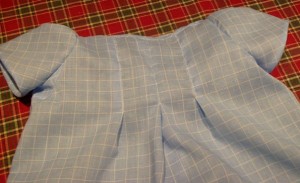 Idea number two: Pleats
Idea number two: Pleats
I love pleated little girls’ dresses. Very classic, gives great results. Now, I knew I had quite a bit of space in the front, but wanted more fabric to make more pleats (pleats! pleats! More pleats!). So, here is how I got myself more fabric:
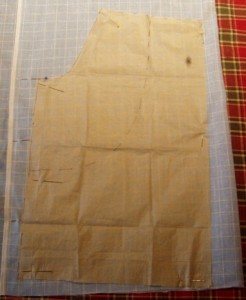 The original pattern piece for the front (and back, too) of the dress/top calls for you to put the center on the fold. I measured out an inch at the neck edge and put the center of the pattern there. Then, I swung the bottom out to give me even more fabric at the bottom. I’d already decided that I’d just put one pleat in the center of the back.
The original pattern piece for the front (and back, too) of the dress/top calls for you to put the center on the fold. I measured out an inch at the neck edge and put the center of the pattern there. Then, I swung the bottom out to give me even more fabric at the bottom. I’d already decided that I’d just put one pleat in the center of the back.
The second decision I made is that I wanted sleeves in this (OH NO! What do we do?)
Well, first of all, because of the way this was designed (no sleeve, just armscye, and the adjustment is made with a string through a casing at the neck), I knew I’d have to ‘raise the armscye’ (which is actually just like ‘raising the flag, actually) by putting a piece of tissue into the bottom of the armhole on the dress and adding an inch at the edge and then grading it into the rest of the armhole. This makes the armscye smaller and the seam on the armscye will be ‘higher’ at the armpit edge.
But, how do we create a sleeve pattern where there is no sleeve pattern?
Well, first of all, we have to decide a) what sort of sleeve we want, and we have to ‘walk the armscye’ to find out how big the armscye actually IS.
What sort of sleeve? Well, this is for a very sweet little girl so only some sort of puffy sleeve will do.
Walking the Armscye:
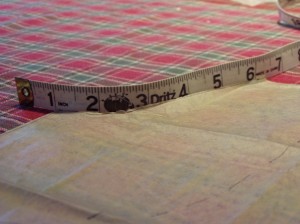 “walking’ is determining how long some item on the pattern is by lining up a cloth measuring tape against it and following the curves. By measuring in this way, we know exactly how long the space is (and of course in this case, it also includes the seam allowances. Now, I’ve measured only one half, so I need to multiply this figure by 2 to get the entire length of the armscye from front to back. Now, since we also want a puffed sleeve, we need to make that length LONGER, so that we have the extra fabric at the top to gather or pleat into the armscye to make the sleeve puff like that (a tip I picked up from Ronda Chaney’s book). How do we do that?
“walking’ is determining how long some item on the pattern is by lining up a cloth measuring tape against it and following the curves. By measuring in this way, we know exactly how long the space is (and of course in this case, it also includes the seam allowances. Now, I’ve measured only one half, so I need to multiply this figure by 2 to get the entire length of the armscye from front to back. Now, since we also want a puffed sleeve, we need to make that length LONGER, so that we have the extra fabric at the top to gather or pleat into the armscye to make the sleeve puff like that (a tip I picked up from Ronda Chaney’s book). How do we do that?
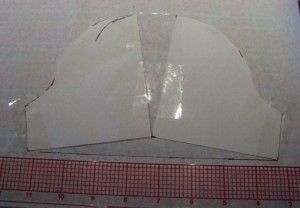 Now, because I had ‘walked the armscye’ and multipled by 2, I knew what the basic length of the curve at the top of the sleeve pattern had to be (and if you don’t know how to draft a sleeve pattern, How to draft a sleeve pattern or if you have a sleeve from another pattern you can ‘frankenpattern’ that) and I drafted a very simple short sleeve out of that. But again, how to get more fabric just at the top? As you can see from the photo, I slashed the pattern in the middle all the way to just before the bottom and spread it about an inch, taped on extra paper and trued it up with my curve at the top. Now doing this (and you can see this at the bottom of the photo) makes the edges of the bottom of the sleeve go down..and we don’t want that. So, I lined up a straight edge across the edges and drew another line. This also makes the vertical edges of the sleeve go in and we don’t want that, either, so, using my straight edge, I trued that up at 90-degrees to the bottom line. And voila! New puffed sleeve pattern.
Now, because I had ‘walked the armscye’ and multipled by 2, I knew what the basic length of the curve at the top of the sleeve pattern had to be (and if you don’t know how to draft a sleeve pattern, How to draft a sleeve pattern or if you have a sleeve from another pattern you can ‘frankenpattern’ that) and I drafted a very simple short sleeve out of that. But again, how to get more fabric just at the top? As you can see from the photo, I slashed the pattern in the middle all the way to just before the bottom and spread it about an inch, taped on extra paper and trued it up with my curve at the top. Now doing this (and you can see this at the bottom of the photo) makes the edges of the bottom of the sleeve go down..and we don’t want that. So, I lined up a straight edge across the edges and drew another line. This also makes the vertical edges of the sleeve go in and we don’t want that, either, so, using my straight edge, I trued that up at 90-degrees to the bottom line. And voila! New puffed sleeve pattern.
Making the pleats:
So, how did I know how much to pleat and how much to pleat? Well, one rule of thumb I use is that odd numbered things are more interesting than even numbered things, so I knew I’d use one or three, not two. I already had added fabric in the center front for one bit pleat, so I added two little pleats at either side and test pinned it to make sure it measured that magic number we got in the beginning, which was 7″. I made the back pleat in the center also and made sure that met the measurement as well.
Disaster Avoidance!
I always have to remember the neck on this, and realized that once I put the sleeves in, I had to attach them to something, so the neck would be even smaller. So, I put an oblong slit in the neck in the back, bias-bound that (and put a snap on it), and THEN bias bound the front and back before I sewed them together at each shoulder and put in the sleeves. That way, the opening at the back would not interrupt the pleat in the back. I also added a bit of eyelet embroidery at the bottom as a little bit of fancy.
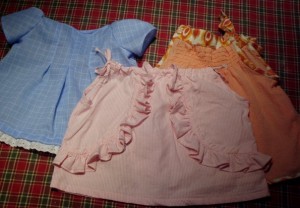 So, there you go. one pattern, three different little dresses. Three ways of handling the ‘make the fabric smaller issue (draw string, gathering and smocking, pleating), three very different looks.
So, there you go. one pattern, three different little dresses. Three ways of handling the ‘make the fabric smaller issue (draw string, gathering and smocking, pleating), three very different looks.
